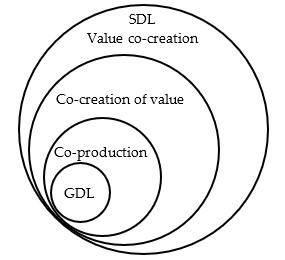Vargo and Lusch (2004, 2008, 2016) developed a service-dominant logic (SDL) delineating a new service marketing theory and introduced 11 foundational premises (FPs). They noted the definition of service as the application of specialized competencies (knowledge and skills) to enhance individual benefits, processes, and performance. This definition is relevant to explaining how SDL captures resources. In SDL, operand resources are resources that produce an effect after an operation or act is performed; operand resources act on operand resources. Mainstream marketing shifts from operand resources to operant resources. Moreover, according to Lusch et al. (2007), SDL is based on understanding the interwoven fabric of individuals and organizations, brought together into networks and societies, specializing in, and exchanging the application of competencies they need for their own well-being (p. 5).
Value prepositions are considered to be essential premises of value co-creation.This study regard value co-creation as the upper concept relative to value prepositions and human-centered approach.
- service-dominant logic
- value proposition
- Value co-creation
- Human centered approach
Vargo and Lusch revised the FPs in SDL in 2004, 2008, and 2016, introducing 11 FPs in the final revision and presenting the conceptual foundation for SDL axioms. In their recent revision, they pointed out the need to specify the coordination and cooperation mechanisms involved in value co-creation through the market as well as society, emphasizing both the institutional perspective of SDL and service ecosystem perspective. SDL redefines the service ecosystem as a relatively self-contained, self-adjusting resource system integrating the actors by shared institutional arrangements and mutual value creation through service exchange. Lusch and Vargo (2014) also suggested that the service ecosystem has a nested structure consisting of micro, meso, and macro systems. The different actors in the service ecosystem co-create value through interaction at various levels to create different value proposition categories. Quero and Ventura (2019) used value proposition as a framework to analyze value co-creation in Spanish business crowdfunding ecosystems. In a qualitative multiple case study, they analyzed the crowdfunding platforms in micro-, meso-, and macro-contexts to find that crowdfunding can be considered a service ecosystem once all the participants exhibit positive synergies in funding.
Lusch and Vargo (2016) presented the core concepts of SDL as follows: service is the fundamental basis of exchange (FP1), the customer is always a co-creator of value (FP6), all social and economic actors are resource integrators (FP9), value is always uniquely and phenomenologically determined by the beneficiary (FP10), and value co-creation is coordinated through actor-generated institutions and institutional arrangement (FP11). Using SDL, Mele (2009) analyzed the value innovation in business-to-business relationships in both the manufacturing and service sectors. She argued that innovations develop value propositions, which in turn provide customer service solutions through the integration of goods, services, systems, processes, and technology. However, value co-creation is coordinated through actor-generated institutions and institutional arrangements and created and determined through user consumption and the interaction of actors. Furthermore, value co-creation is created through reciprocal services based on engagement between business actors and partners.
According to Lusch and Vargo (2006), value co-creation has two components: co-creation of value and co-production. The first component is the co-creation of value. This represents the creation and generation of value through the interaction of business actors and the customer and is not the addition of value. The second component is co-production. Lusch and Vargo (2006) showed that under co-production, users collaboratively produce goods with producers, for example, through shared inventiveness, co-design, co-use, or shared production of goods through the value network. They also pointed out that co-creation is superordinate to co-production, although the concepts form a nested structured. Figure 1 presents the encompassing relationship between SDL and goods-dominant logic (GDL) as modified by Taguchi (2010).

Figure 1
Outline of the Analytical Framework
This section outlines an analytical framework based on the literature reviews. This study explores how and what collaborative interactions create value propositions though value co-creation and analyzes the value propositions based on two Japanese case studies, the Onomichi Denim Project and REKROW. The study applies SDL to analyze the micro- level service ecosystem in both case studies, framing the interaction between the business actor and customer (B-C), and between the business actor and business actor (B-B) to investigate the value propositions. Additionally, Vargo and Lusch (2016) noted that the relationship between business actors in the SDL does not strictly define the producers or consumers because they engage in benefitting their own existence by benefiting other enterprises through service-for-service exchange. Thus, this study regards B-C and B-B as social and economic actors and their interaction as service-for-service exchange.
Figure 2 presents the analytical framework illustrating the concepts of value co-creation and the human-centered approach as modified by Groonroos and Voima (2013). Gronroos and Voima (2013) suggested that value creation involves a customer sphere and provider sphere. This study interprets the concept of Gronroos and Voima (2013) and adopts four human-centered approach, namely, co-design, co-creation, co-production, and co-use. In Figure 2, value in exchange is applied as service-for-service exchange for not only B-C, but also B-B. Additionally, this study regards value co-creation as the upper concept relative to human-centered approach.

Figure 2
This entry is adapted from the peer-reviewed paper 10.3390/su14063502
